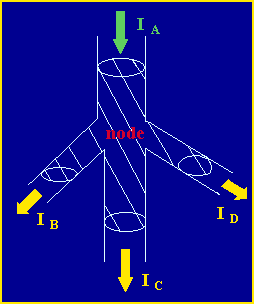- Kirchoff's Current Law
Kirchoff's Current law can be stated in words as the sum of all currents flowing into a node is zero. Or conversely, the sum of all currents leaving a node must be zero. As the image below demonstrates, the sum of currents Ib, Ic, and Id, must equal the total current in Ia. Current flows through wires much like water flows through pipes. If you have a definite amount of water entering a closed pipe system, the amount of water that enters the system must equal the amount of water that exists the system. The number of branching pipes does not change the net volume of water (or current in our case) in the system.

- Kirchoff's voltage law
Kirchoff's voltage law can be stated in words as the sum of all voltage drops and rises in a closed loop equals zero. As the image below demonstrates, loop 1 and loop 2 are both closed loops within the circuit. The sum of all voltage drops and rises around loop 1 equals zero, and the sum of all voltage drops and rises in loop 2 must also equal zero. A closed loop can be defined as any path in which the originating point in the loop is also the ending point for the loop. No matter how the loop is defined or drawn, the sum of the voltages in the loop must be zero.

This blog is for circuit hungry people. Those people that are interested in practical work rather than software. This blog is for Engineers and Technicians who chooses either Electrical, Electronic, Telecom as there field. From basics to High Level Projects circuit diagrams with details are given in this blog that not only helps in developing practical knowledge but also strong the theoretical knowledge of students.
Monday, July 20, 2009
Kirchoff's current and voltage laws
Subscribe to:
Post Comments (Atom)
No comments:
Post a Comment